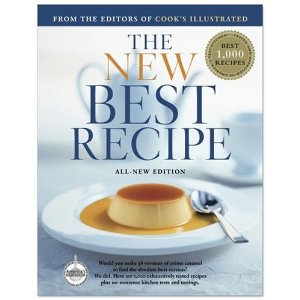I was looking for a recipe a couple days ago, and having no luck in finding it until I realized it was in one of my lesser-used cookbooks. That got me thinking about how despite owning a lot of cookbooks - a whole small bookcase full, in fact - I get a lot more use out of some of them than I do others, and particularly tend to rely on a small number of them for a lot of my cooking.
Probably the top of my list of go-to cookbooks is the America's Test Kitchen Family Cookbook, currently in its third edition. I own the Cookware Rating edition, which - naturally enough - features suggestions for "best of class" and "best value" among the various sorts of cookware available. Want to know what the ATK folk think is the best value for a chef's knife (you might be surprised to discover they recommend a relatively low-cost brand) or which non-stick skillets hold up the best to regular use? Then this is the book for you. That said, the real value is in the rest of the book, which includes tons of good cooking tips, 1200+ recipes and lots of great illustrations. Most of what's presented is pretty standard stuff, but there are the occasional surprise recipes, plus a lot of useful "root recipes" one can use as the basis of a lot of variations. I've found this helpful for pie crusts, among other things. All of the recipes have been rigorously tested by the America's Test Kitchen staff, and I've not yet found one that wasn't good.
Also from the ATK/Cook's Illustrated folk is The New Best Recipe. Whereas the ATK Family Cookbook presents everything in a very straight-forward, no-frills manner, The New Best Recipe is intended for cooking geeks. Written in the technical Cook's Illustrated format, it features in-depth discussion of recipe testing and lengthly sections about various cooking techniques. It also features a somewhat fancier and more esoteric bunch of recipes, over 1000 of them. If you are just looking for stratightforward recipes, you would be better off with the ATK Family Cookbook, but if you're interested in comparisons of how different techniques interact with different cuts of meat, or find food science fascinating, this is one you will want.
I am also a big fan of the Good Housekeeping Cookbook 125th Anniversary Edition. This is another basic cookbook which covers a lot of the same ground as the ATK Family Cookbook, but from a somewhat different perspective. I often find it helpful to look at several recipes for the same dish when developing my own version, and the two I tend to rely upon the most are this one and the ATK Family Cookbook. Looking at commonalities between different versions of the same recipe, and also paying attention to the small differences that can make a big difference in flavor or ease of cooking, has made me a better cook. Considered exclusively on its own merits, the Good Housekeeping Cookbook is a great deal, featuring 1275 solid, well-tested recipes, many of which have withstood the test of time.
My next favorite is the Complete Step-By-Step Cookbook. It is available in different editions by two different publishers, but as far as I can tell the contents are functionally identical, even down to identical illustrations. For what it's worth, I have the Salamander edition, but again, I think the Thunder Bay Press edition is identical. The promotional blurb about this book including everything the home cook could possibly hope for is a bit hyperbolic, at least in regard to this particular home cook, but I've been pleased by every one of the 800-odd recipes in this book that I've gotten around to making (probably about 50), and it has given me a lot of good ideas for my own recipes and for use in customizing standard recipes. It features concise instructions and beautiful illustrations, and I can't imagine an amateur or home cook not finding some good stuff here. This book has been around for awhile, and it is readily available for cheap at Amazon.
I've mentioned the next favorite before, but it's worth mentioning again, because Camellia Panjabi's 50 Great Curries of India truly is a great book. This has become my go-to book for Indian cooking. It features a great opening discussion of Indian culinary traditions and philosophy, and in terms of recipes, I've not yet found a book that features a better range of dishes drawn from the various Indian regional cuisines. Plus, in addition to the "50 great curries" advertised in the title, this one features lots of recipes for Indian breads, sauces, vegetable and rice sides and so forth, putting the total number of recipes closer to 100.





No comments:
Post a Comment